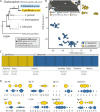Mutualistic microalgae co-diversify with reef corals that acquire symbionts during egg development
- PMID: 34012104
- PMCID: PMC8528872
- DOI: 10.1038/s41396-021-01007-8
Mutualistic microalgae co-diversify with reef corals that acquire symbionts during egg development
Abstract
The application of molecular genetics has reinvigorated and improved how species are defined and investigated scientifically, especially for morphologically cryptic micro-organisms. Here we show how species recognition improves understanding of the ecology and evolution of mutualisms between reef-building corals and their mutualistic dinoflagellates (i.e. Symbiodiniaceae). A combination of genetic, ecological, and morphological evidence defines two sibling species of Cladocopium (formerly Symbiodinium Clade C), specific only to host corals in the common genus Pocillopora, which transmit their obligate symbionts during oogenesis. Cladocopium latusorum sp. nov. is symbiotic with P. grandis/meandrina while the smaller-celled C. pacificum sp. nov. associates with P. verrucosa. Both symbiont species form mutualisms with Pocillopora that brood their young. Populations of each species, like their hosts, are genetically well connected across the tropical and subtropical Pacific Ocean, indicating a capacity for long-range dispersal. A molecular clock approximates their speciation during the late Pliocene or early Pleistocene as Earth underwent cycles of precipitous cooling and warming; and corresponds to when their hosts were also diversifying. The long temporal and spatial maintenance of high host fidelity, as well as genetic connectivity across thousands of kilometers, indicates that distinct ecological attributes and close evolutionary histories will restrain the adaptive responses of corals and their specialized symbionts to rapid climate warming.
© 2021. The Author(s), under exclusive licence to International Society for Microbial Ecology.
Conflict of interest statement
The authors declare no competing interests.
Figures




References
-
- Tewksbury JJ, Anderson JGT, Bakker JD, Billo TJ, Dunwiddie PW, Groom MJ, et al. Natural history’s place in science and society. Bioscience. 2014;64:300–10. doi: 10.1093/biosci/biu032. - DOI
-
- Leliaert F, Verbruggen H, Vanormelingen P, Steen F, López-Bautista JM, Zuccarello GC, et al. DNA-based species delimitation in algae. Eur J Phycol. 2014;49:179–96. doi: 10.1080/09670262.2014.904524. - DOI
-
- Potter D, LaJeunesse TC, Saunders GW, Anderson RA. Convergent evolution masks extensive biodiversity among marine coccoid picoplankton. Biodivers Conserv. 1997;6:99–107. doi: 10.1023/A:1018379716868. - DOI
Publication types
MeSH terms
LinkOut - more resources
Full Text Sources
Other Literature Sources

